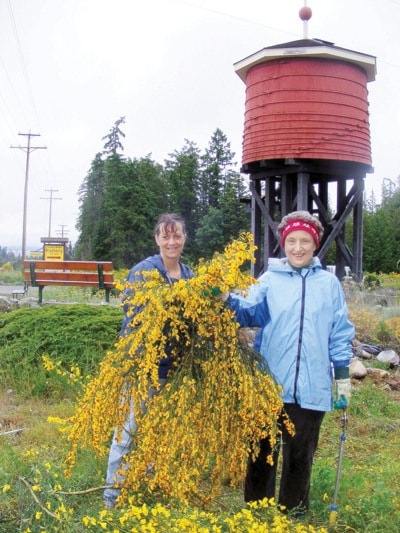Part of an ongoing series of articles relating to critical issues affecting the Mount Arrowsmith Biosphere Reserve; written by members of the Mount Arrowsmith Biosphere Foundation.
Perhaps I’m like you. I’m not a native Islander. When I first moved here, the broom was in bloom. Bright yellow flowers lit up the highway corridors, parking lots, ditches and much more. What I didn’t know at the time is that Scotch broom (Cytisus scoparius) is a highly invasive alien species imported from Europe.
Scotch broom is a serious problem globally, from Australia to Brazil to the Mediterranean.
Across the Pacific Northwest, and on Vancouver Island especially, heavy concentrations of broom have led to a problematic displacement of native plant species. Broom forms dense thickets which are a fire hazard, affect growth of both natural and planted conifer seedlings, and are known to impact Garry oak woodlands. Seeds can also be poisonous to livestock. According to the Oregon Department of Agriculture, Scotch broom costs the state of Oregon about $47 million each year by its impact on resources, particularly on timber production.
Why is Scotch broom so invasive?
A mature broom plant can produce as many as 10,000 seeds per year that can lay dormant in the soil for 40 years or more. The long-lived seeds are easily transported by vehicles and will germinate in any open or disturbed soil, from roadways and pastures, to remote forestry cut blocks. This high level of seed production, seed longevity and effortless distribution creates a nightmare for gardeners, farmers, landowners, foresters, maintenance crews and industry, just about everyone.
Scotch broom is difficult to control once it has become established, so preventing the spread is key.
Broom will die if you cut it in bloom at ground level. Cut the broom in late April or May, before the seed pods form. To learn how to cut broom and join ongoing broom removal projects near you, go to www.broombusters.org.
Scotch Broom is one alien invasive plant that we can do something about. Join us. Spring is the time. You are especially welcome to join in with “Remove your Broom” cutting events organized by Broombusters and the Mount Arrowsmith Biosphere Foundation in late April and May. Check websites for details (www.mabr.ca).
We will focus removal efforts in the core protected areas of the Mount Arrowsmith Biosphere Reserve to conserve our regional biodiversity.
Hope to see you there.
— This column was written by Karen Hunter, MABR Coordinator.
